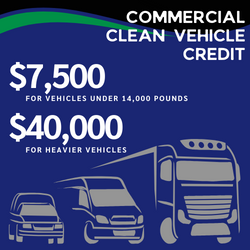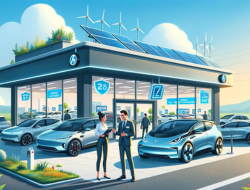Maximizing Business Benefits with 2024 EV and EV Charger Tax Incentives
Introduction
As the quest for cleaner air intensifies, the spotlight turns to light-duty vehicles, which account for approximately 28% of pollution in the United States. To combat this, the government has rolled out significant incentives aimed at encouraging the adoption of electric vehicles (EVs) and the development of EV charging infrastructure. Despite the intricate details, 2024 offers a prime opportunity for businesses to embrace these incentives for EV adoption and infrastructure development.
2024 EV Tax Incentives: What Businesses Need to Know
1. Commercial Clean Vehicle Credit 
A new tax incentive is now available for businesses that can claim depreciation on their taxes. This includes a maximum credit of $7,500 for vehicles with a gross vehicle weight rating (GVWR) under 14,000 pounds and $40,000 for heavier vehicles. The credit is calculated as the lesser of 15% (or 30% for non-gas/diesel vehicles) of the vehicle's cost or its incremental cost, with no cap on the number of credits a business can claim. However, these are nonrefundable credits, meaning they can only offset taxes owed. Read more details of the commercial clean vehicle tax credit on the IRS website here.
Leveraging EV Charger Incentives for Business Advantages
 Businesses installing new EV chargers can also claim a tax incentive of up to 30% of the total cost (capped at $100,000 per charger), subject to certain qualifications. This can significantly reduce the initial investment required and, when combined with potential grant opportunities for chargers accessible to the public, particularly in rural or strategic locations, can enhance the attractiveness of installing EV charging stations.
Businesses installing new EV chargers can also claim a tax incentive of up to 30% of the total cost (capped at $100,000 per charger), subject to certain qualifications. This can significantly reduce the initial investment required and, when combined with potential grant opportunities for chargers accessible to the public, particularly in rural or strategic locations, can enhance the attractiveness of installing EV charging stations.
Whether you are looking to power your own fleet, provide a needed service to your community, or a mixture of both, there are many opportunities out there to make this a wise investment. Search for programs by zip code here.
2. Credit Transfer to Dealers
Known informally as “Cash on the Hood,” this option allows buyers to transfer the $7,500 EV tax credit to the dealer, which can be a significant incentive at the point of purchase. This can replace or add to your cash down to reduce your financed amount. However, if the buyer's income exceeds the limit, they must repay the credit.
3. Purchasing from a Qualified Dealer
It is crucial to buy EVs from dealers registered with the IRS to process the tax credit. Not all dealers are approved. You must buy your EV from a dealer that is registered to process the IRS tax credit. When you buy your new or used EV from a registered dealer, the dealer is required to provide the buyer at the time of sale a seller’s report that carries the penalty of perjury if there is intentionally false information. This report will have a bunch of information, but mostly you will file this report when you do your taxes. Do not take possession of the car until you receive the seller’s report. How do you find out if a dealer is approved? Call the dealer and ask.
4. Vehicle Eligibility
Eligibility for the federal tax credit is not universal across all electric vehicles. Specific models are approved based on stringent criteria, but not all EVs on the list will qualify either. To verify if a vehicle is eligible:
Check the Qualified Models: Start by consulting the list of eligible vehicles on fueleconomy.gov. This list is continually updated, reflecting the latest models that meet the tax credit requirements.
- MSRP Limits: There are price caps in place — $55,000 for cars and $80,000 for trucks.
- Battery Sourcing: At least 50% of the critical minerals in the battery must originate from the U.S. or a U.S. free trade agreement (FTA) partner.
- Manufacturing Locations: A minimum of 60% of the battery components should be manufactured or assembled in North America.
- VIN Verification: Your dealer can check the vehicle's VIN against the IRS requirements to confirm eligibility. This step ensures that the vehicle meets all the necessary guidelines, including those not covered in the initial model list.
5. Income Limitations
There are income thresholds for tax credit eligibility. For 2024, these are set at $150,000 for single filers, $300,000 for those married filing jointly, and $225,000 for head of household. Exceeding these limits may require repayment of the credit. One of the things you must give to the dealer is your estimated adjusted gross income for the current tax year.
If your filing status changes from the year prior to your purchase and the current tax year, and you would have qualified for the income limit under your previous filing status, then the income limit is forgiven for the current tax year. One example of this situation would be a couple who marry and now make over the income limit. This loophole allows the couple to still utilize the credit, even though their new income levels put them over the top.
6. Inclusivity of the Tax Credit
Starting in 2024, the credit is available regardless of the taxpayer's liability, meaning it can be claimed even if the tax owed is less than the credit amount.
7. Used Vehicle Eligibility
For the first time, used vehicles are eligible for a tax credit up to $4,000, subject to specific conditions including model year, price, and income limits.
Criteria for used vs new vehicles are different:
- The vehicle model year must at least 2 years earlier than the calendar year when you buy it.
- Must have never had a used vehicle credit applied previously.
- The negotiated price (not MSRP) must be less than $25,000.
- The EV is not under the same certification requirements, but the dealership selling the vehicle must still be registered with the IRS and similar reporting requirements are in effect.
- The maximum income limits for used cars are lower than for new cars. Joint married $150,000, head of household $112,500, and $75,000 for single.
8. Leasing Considerations
 While lessees cannot directly claim the credit, leasing companies may pass on some or all of the benefits to the consumer. The best advice for consumers who wish to lease is to review the total cost, including the money factor, carefully to see if they are getting the full benefit of the tax credit, part of it, or none of it. Consumer Reports maintains a list of which cars get a lease tax credit and which ones do not.
While lessees cannot directly claim the credit, leasing companies may pass on some or all of the benefits to the consumer. The best advice for consumers who wish to lease is to review the total cost, including the money factor, carefully to see if they are getting the full benefit of the tax credit, part of it, or none of it. Consumer Reports maintains a list of which cars get a lease tax credit and which ones do not.
Conclusion
The transition to electric vehicles presents a valuable opportunity for businesses to reduce both upfront and long-term operational costs. Beyond financial savings, adopting an electric fleet and installing EV chargers can enhance your company's brand image, attract more customers, and contribute to a sustainable future. At Energy Options, we're dedicated to assisting businesses in navigating these incentives and implementing effective EV charger solutions. Contact us for a free consultation and explore how you can benefit from these opportunities in 2024.



